It's New Year's day, most of the alcohol has gone (along with the headache), it's the evening time, Westfield are still shut for the Christmas period, and we're running out of things to do with the lack of driveshaft on one side, so we decide that now would be a good time to tackle the dry sump system. Up until now, then engine has lived in a plastic crate on a pallet straight from Yorkshire Engines, so we lift it out. The box weighs a tonne so I was really not looking forward to this, but once we took the exhaust manifold, ECU, wiring loom, fuel pump, and all of the other odds and ends out of the box, it felt a lot lighter.
In fact, once we had a decent grip on it, Matt and I could comfortably lift it out of the box and on to the pallet. No engine hoist needed here! We had a box full of the dry sump kit, and a set of instructions that were faxed to Matt and really weren't that clear at all as a result - this could be interesting!
We tilted the engine over being careful not to crush anything, and then took the sump off. The engine is virtually new at 800 miles old (we opted for one that was literally run in instead of brand new so we wouldn't have to run it in ourselves). Due to the young age of the engine, the bolts came off like they were brand new.
After 14 or so bolts were removed the sump literally fell off exposing a very healthy looking inside. The dry sump is much more shallow that the original, so you need to remove the original oil pickup and discard it, and then you need to remove the oil return feed and shorten it so the new sump can be fitted. Stupidly as I was refitting the pipe I dropped the bolt into the gearbox and sent myself into a state of panic thinking I'd never find it. I got my magnetic retrieval tool and found it almost immediately though - phew!
The new sump could now be fitted to the engine. Westfield supply 2 new sump gaskets and a baffle within the kit, as well as new sump bolts to replace the original bolts. The order is gasket on to bottom of engine, then baffle, then another gasket, and then the sump itself. This seals the baffle and the sump itself. You then just fix it back into place using the new bolts and spring washers. The next job is to fit the oil pump, but that's probably a job for another evening as it's cold and I'm hungry.
Laurence
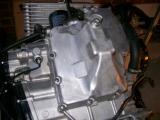 |
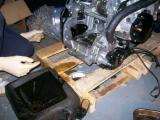 |
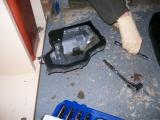 |
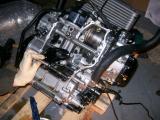 |
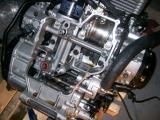 |
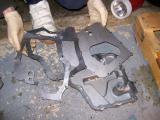 |
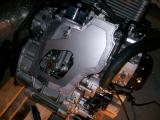 |
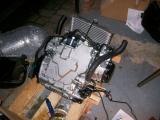 |
Now the dry sump is fitted the scavenge pumps can be fitted which pull oil out of the sump and into the remote oil reservoir. This is a lot more complicated than it sounds though - it runs off the engine like an alternator does, but you have to extend the rotation of the crackshaft out so that the pump can make use of it. Luckily Westfield's dry sump kit has an excellent solution to this.
You start by removing the starter motor drive cover and are immediately faced with gears and other stuff that you would be a bit reluctant to disassemble, but then immediately you learn you have to remove them. Luckily I have the workshop manual for the engine if I get stuck.
You then take off the starter motor clutch cover next to it, allowing the whole unit to be removed which roughly resembles a figure of 8 shape. On the larger of the two covers, you need to remove the centre cover which covers a bolt, and you replace it with the Westfield supplied insert which has a hole in the centre for a shaft to run through it.
Now the bolt needs to come off the starter clutch, but you will find that turning it with a ratchet will turn the engine instead of loosening the bolt, so you need to shock the bolt off. Strike the ratchet with a hammer a few times instead of pushing with your hand and the bolt will free itself.
The pulley drive flange has 3 drive pins which fit into the starter clutch now that the bolt is removed, and you quickly start to see exactly how the whole set-up works. You need to insert the 2 roll pins into the drive flange before fitting into place. I found the best way to do this was with 2 people, a pair of fine nosed pliars, and a small hammer.
Once the pins are in place, the pulley drive flange can be offered up to the starter clutch, and secured into place with a few taps of the hammer. once this is in place, the starter clutch cover can be put back into place with a new gasket, and you quickly see why you had to put the Westfield part had to be fitted to the cover - the pulley flange pokes right though it. With the pulley fitted to the shaft, you can tighten everything back up again.
A new bolt needs to be fitted to secure the pulley assembly into place - you can get this tight, but it will spin the engine before you hit the specified torque (like when you took it off), so don't use threadlock yet. You can tighten it when the drive flange is fitted to the engine - read on to the later section for details...
Laurence
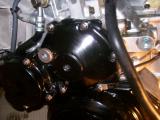 |
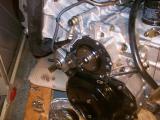 |
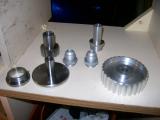 |
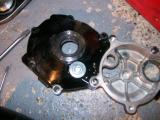 |
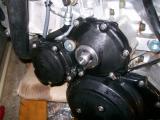 |
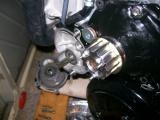 |
Continuing on with the dry sump fitting, now that the pulley to power the scavenge pump was installed, it was time to fit the scavenge pump itself. The pump fixes into the bracket just fine, and then the bracket uses a few existing bolts to fit onto the engine, but the oil filter needs to come off to remove one of the bolts that the bracket uses, and it's stuck fast. No amount of twisting with my hands will get the filter off, so I'll need a tool, and everything I have tried won't work. Not a huge amount of work done on the engine tonight then!
Laurence
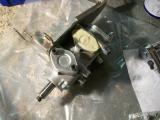 |
Carrying on from the other night, to remove the oil filter I tried using an oil filter wrench which is basically a strap which wraps around the filter, and then a ratchet is used to tighten the strap on to the filter and the twisting motion breaks it free. It doesn't work though because the filter is done up 2 whole turns after the seals touch - it's normally half a turn on a car, so it's very, very tight!
Eventually, a huge plumber wrench does the job by crushing the filter to get a grip on it, and then it just twists off. Now with the filter removed I can remove the bolt that was being blocked by the filter, and fit the oil pump bracket to the engine, but the bracket doesn't fit that well when you try and secure it to the engine, and I had to open up a couple of the holes a little. Even with this, it's still not a great fit. The trick eventually was to get all of the bolts in place very loosely, and then tighten each one a bit at a time which shapes the bracket to fit.
Everything looks fine until I try to fit the new oil filter, but it fouls the oil pump bracket. The only choice is to shave the edge off the bracket, but directly beneath is the open oil filter thread. I don't want swarf getting in, nor do I want to remove the bracket again due to its poor fit, so I cover the entire area over and begin filing. After a short while, enough of the bracket has been taken off and the filter fits just fine.
Now with the scavenge pump fitted, the oil pipes that come from the sump must be connected to the scavenge pump. This is quite fiddly because You can't get a ratchet to the Allen head bolts in some cases, so you have to use an Allen key a quarter-turn at a time, but you get there eventually. It was a process of elimination working out which pipe went where, but I got there in the end.
I then fitted the two metal pipes to the scavenge pump itself, again, using a process of elimination. This is even more fiddly though, and I had to file down the weld on one of the pipes as the small nut kept hitting the weld and wouldn't thread.
Now all that remains is to connect up the pipes using the flexible hose. The easiest way to do this is to slacken off the bolts on the metal pipes so you can move them around. This helps loads when trying to slip the flexible hose onto both ends of the metal pipes.
It wasn't long before I ran into a problem though - with the right-most pipes connected, the left pipe touches it. This is with all pipes not tightened - it will be impossible to tighten them further too. Something is wrong, so I'll have to speak to Westfield and find out if I have got the pipes fitted in the wrong places, or if the pipe(s) themselves are wrong!
Just before I finished for the night, I remembered that Westfield need the Hayabusa wiring loom so that they can modify it, so I packed it up ready. In addition to this they need a section of the Hayabusa fuel rail. I understand that a bike runs lower fuel pressure, so they only feed fuel into the fuel rail. However a car runs higher fuel pressure, so the fuel rail must have a send AND a return, so they need the last section of fuel rail and they modify it into a T piece to form a return.
You need to unscrew the injectors and pull them out, then the fuel rail sections just pop out when you pull them. You need to send Westfield the left-most section in the picture below, which is the opposite side to the brass feed on the right.
Laurence
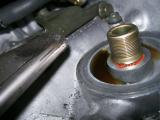 |
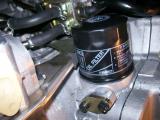 |
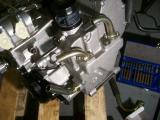 |
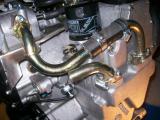 |
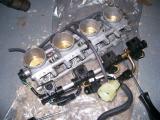 |
Just a couple of little bits today as we're still waiting for parts before we can continue on the main stuff, so we thought we'd clear some of the more minor jobs that will no doubt add up at the end if we don't.
One of these is the radiator. Be warned - the SEi manual bares almost no likeness to the Megabusa radiator, and neither does its fitment! I had already looked at it previously and gave up. Earlier in the week I had rang Mark at the factory to find out more about it, and he told me that it mounted to a separate bracket which is why I couldn't work it out. He send me some pictures through which I have attached below.
You need to:
- Mount the radiator plate to some brackets.
- Rivet the brackets to the chassis when you are happy that they are evenly spaced
- Remove the plate from the brackets.
- Fix the fan inside the plate
- Re-fit the plate
- Fix the radiator to the plate.
We found that the easiest way to drill the bracket holes into the chassis was through the brackets themselves, that way the hole was already aligned with the hole in the bracket. Very easy, and then just 6 rivets to fix.
I got all of this done, and then couldn't work out which bolts to use as they all seem too long for the radiator thread, so I leave the radiator off. Probably a good idea actually as the chassis will be lifted down off the stands soon, and the radiator will probably be in the way.
Now that the radiator brackets were fixed, we could fit the horn without fear of it overlapping the rad brackets, so back out came the drill. We had to bend the horn bracket, but it was best to use the chassis rail we were mounting it to, which gave a perfect bend. Once fitted into place I couldn't resist putting a battery across it - "Beep Beep" :)
Laurence
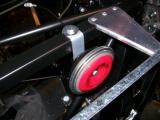 |
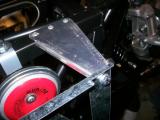 |
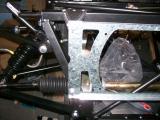 |
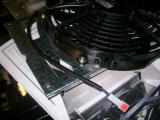 |
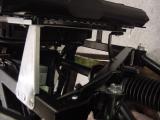 |
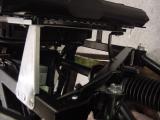 |
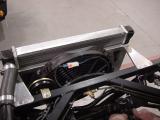 |
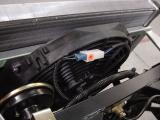 |
Westfield sent a new stub shaft to replace the nearside item that didn't fit. However, they have sent me an offside shaft. So now I have 2 offside shafts. No point doing anything today, and I leave the garage very annoyed!
Laurence
Back over Christmas we discovered that our nearside stubshaft didn't fit through the hub, and Westfield got another one to us a week after New Year. Unfortunately they had send us another offside instead. When I contested this with them they told us they had sent us a nearside! Hhhhhhmmmmm.......
After a bit of talking and checking, we worked out that the manual was wrong. The SEi manual states that the nearside has a white nut with a reverse thread, but it is infact the offside that should have this driveshaft, as the nuts must be tightened in the opposite direction to the wheel rotation! Makes sense now.
So Westfield did in fact send the stub shaft that I asked for (nearside), and I had asked for the wrong one, but this is only because their manual is wrong. At the time of writing, page 66 of the SEi construction manual is wrong. The nearside driveshaft outer (stub shaft) has a conventional thread and is fastened with a green nut. The offside has a reverse thread and is fastened with a white nut.
This still doesn't help my situation though. I still have two conventional threaded stubshafts, and on top of this I have to swap the stubshaft I have fitted on the offside to the nearside, which means removing the brakes and the drive shaft. Westfield parts are extremely good though and sorted it out very quickly once they realised what the problem was, and the correct one will be with me this week.
Laurence
The correct stubshaft is now here along with a few other bit, so tonight I have to remove the one I have fitted in the offside, and fit it into the nearside (see previous post). This means removing the driveshaft and also the rear brake assembly. In the end I didn't have to remove the driveshaft - I just disconnected the outer end from the stub shaft and then disconnected the upright to allow it to pass through.
Once this was done, I swapped the new stubshaft in and through the upright, and connected it all back up again. I then fitted the stubshaft on the other side, fitted the driveshaft and then the brakes.
The last thing to do this evening was torque all 24 of the drivehsaft bolts up using threadlock. This is quite time consuming because there is not much room to work with, and the handbrake is still slack so the wheels begin to turn before you reach your torque limit. The easiest way to combat this is to fit a rear wheel which you can hold whilst tightening which will prevent the driveshaft from turning.
Unfortunately I forgot to take any pictures :(
Laurence
In today's delivery from Westfield was a new scavenge pipe. Earlier in the diary I posted a picture where the two scavenge pipes were touching. I sent this same picture to Westfield and they agreed that it was not right, so they sent me a new one to try.
Immediately the new pipe looks better, but the entire right-hand pipe has to come off to gain access to fit the new one, so lots of fiddling and it looks a lot better. The flexible pipes are very solid and are a bit of a challenge to get into place, but eventually they went on and the new pipe did the job perfectly.
With these fitted, the only thing left to do is connect the pump pulley to the engine using the supplied belt. It's very tight, and the engine needs to be gently turned which eases the belt into place. It looks very near the front of the scavenge pump pulley, but it's very tight and it won't go on any further. Hopefully it will be ok.
I used the allen head bolt that was fitted onto the starter clutch earlier in the dry sump fitting process to turn the engine which in turn spun the pulley. This bolt will need to be torqued and threadlocked which I'll do once I have changed the output sprocket for a driveshaft flange to give me something to lever off, otherwise the engine will just spin like it's doing now to fit the belt.
Laurence
This is the day that Matt had been waiting for, and it had finally come. Everything that requires the car to be waist-height had now been ticked off the list and the car could now be dropped to axle stands so the engine could be dropped in.
We had set aside Saturday the 19th Jan for several people to come round and help. There were several methods we talked about to get the car down from such a height to the floor, but eventually we decided that the bast way was just to get a team of people to help lift it down manually.
However, between the last session and today, I realised I had used Loctite threadseal and not threadlock on the driveshaft bolts. I assumed that the yellow Loctite tube supplied with the dry sump kit was threadlock, but luckily I checked and it's threadseal instead! What this does mean is that each bolt needs to be removed, cleaned, threadlocked, and refitted. The bolts really weren't locked at all though. To speed up the process I removed one, gave it to Kriss to clean the threadseal off, and fitted the previous one whilst I was waiting each time. I used Loctite 243 which is oil tolerant, and ideal for this application as the bolt passes through grease before locking in the thread.
Whilst I finished this, Matt fitted the aluminium panels that cover the reverse box.
Now on to the main event. The team was formed - Laurence, Matt, Kriss, Marky, Terry, and Lauren. We had 2 options, the first being to lift the car down from the stands straight onto axle stands, and the second being to fit the wheels, lift the car down to the floor, and then jack it up onto axle stands. We decided the second option was the best, and besides, Matt couldn't wait to get the wheels fitted anyway.
With this done, we positioned myself and Matt side by side at the rear of the car, Marky and Terry either side, and Kriss at the front. On three we lift the chassis, and between 5 of us it was very easy indeed. Lauren pulled each of the chassis stands clear, and we gently lifted the car down to the floor.
Matt's face had lit up - he had lost a lot of enthusiasm for the project with parts not turning up, and the arrival of his (Playstation 3), but now he could see it was really looking like a car, he was back in love with the idea of it all again.
We got out 4 axle stands, set them to their highest setting, cut some timber to the width of the chassis, and then just picked up the front of the car and set it down on the axle stands, using the timber to spread the load across the chassis. We then did the same for the rear end.
Seeing the car on the floor made the whole project seem real all of a sudden. The car is so low, and the funniest thing is how high it made the Noble M12 next to it look. It's not often you'll hear that said!
...and still to this day, Matt cannot take a photo that is in focus, so I'm very sorry, but you'll have to make do with what's here!
Laurence
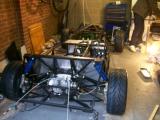 |
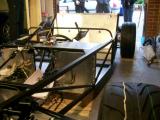 |
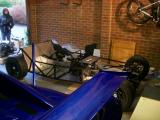 |
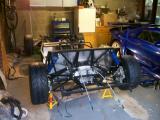 |
Before the engine can be fitted into place, there is quite a bit of preparation work required. Luckily, this section of the build is well documented in the Megabusa manual. You start by fitting the brackets to the clutch slave cylinder, but the image in the manual had them on the wrong way. The 2nd picture shows it fitted, so I used this one to work it out.
In order to bolt this to the engine, you first need to remove the cover that's in the way (pictured below). This covers the chain sprocket, and the original clutch mechanism. A few bolts and the whole thing lifts off, allowing you to fit the new clutch slave cylinder in place and tighten.
Now you fit the engine brackets at either end of the engine. The threads on the engine are extremely soft and I cross-threaded one without any effort at all, but I managed to sort it out by removing the bolt, and threading it straight with some force. I was worried I would have to use a tap, because the bolts have a peculiar pitch to them. Whilst I was having fun with this, Matt finished fitting the removable reverse box panels.
Matt and I are were both heading out for the evening, so we leave it there.
Laurence
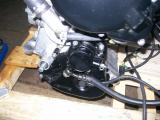 |
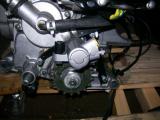 |
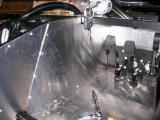 |
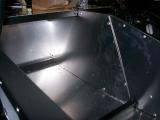 |
Carrying on from yesterday, the engine frame fits to the brackets we fitted previously, but we had forgotten to fit wiring loom saddles to the frame, so we skipped back to the wiring loom section and Matt quickly drilled and riveted them into place.
The frame fixes to the engine using the stud, washers, and bolts. With this in place the frame can then be attached to the brackets. Matt and I found this an extremely tight fit and had to use a lot of force and gradual tightening to make it work. With everything tightened, the engine was now fully ready for dropping into the chassis.
UPDATE:
We later found out this tight fit was due to the cross-frame needing to sit the other side of the brackets. The sequence is bolt, washer, engine bracket, engine frame, washer, nut. We had the bracket and frame the wrong way round. Shame we didn't realise this until we had already lifted the engine in (see later post).
Laurence
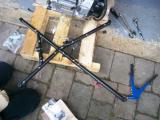 |
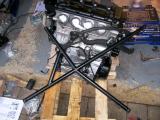 |
We fitted the handbrake with relative ease, but we could not work out how to fit the cable. Mark at the factory sent me several pictures, and I eventually concluded that the securing bracket must have been left off the chassis by mistake. I sent Mark an image, and he confirmed that this was indeed the case.
Mark got the fabrication guys to create a bracket, and in order to fit it, we had to drill through the chassis on both sides, and secure it underneath (normally this would be welded into the chassis from the beginning). In addition to this, I opened up the holes slightly to we could use countersunk screws instead of bolts. We made quite a nice job of this. It's just a shame the bracket wasn't powder coated, but it wouldn't be hard to swap a new one in at a later date, or even remove it and powder coat it ourselves.
Now this was in, we could fit the handbrake cable through it, and onto the rear brakes. You follow the route that the manual shows you, cable tie in a couple of locations, fix to the calipers, and then fix the bracket to the handbrake using a clevis pin and a split pin to secure. We give it a quick go and it works, although it will need adjusting before driving.
There is a grommet situated on each side of the handbrake cable near the caliper. Snip this off as it's not required for the Westfield. Also, you will see some blue sleeves on the cable - these should be used underneath the cable ties.
Now that the rear end is completed, we could drop the tank into place. We had done all of the preparation on the tank already (see earlier post), so all that remained was to put the tank in and strap it down. Ours is the long range version. The tank doesn't feel that secure, and moves around a lot, both forward, back, left and right. I wonder if this could be tighter?
Laurence
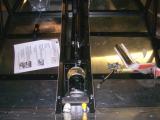 |
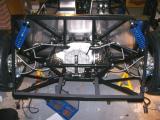 |
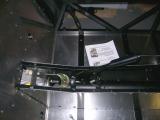 |
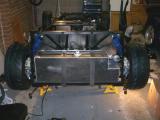 |
We plan to install the engine this coming Saturday, but there are a couple of things that need doing before this can be done.
The drive pulley for the scavenge pump must be threadlocked and torque tightened, and the chain sprocket must be removed and replaced with a propshaft flange since the car does not use a chain.
The problem is, the chain sprocket just spins freely, so how can you take it off? You need to find the gear shift leaver and place it on the gearbox selector. It attaches on the splined shaft which is virtually next to the chain sprocket. Now get the car into gear, and it will couple the gearbox to the engine giving some resistance to push against. You have to remove a securing bolt with an Allen head socket. Now you need an impact wrench to shock the chain sprocket bolt off. With the bolt removed, the sprocket just pulls off.
Now you can put the output flange in its place and refit the securing bolt You need to threadlock it and torque tighten it, but you will find that the flange will begin to turn before you can get enough torque to the bolt (as it exceeds the engine resistance). You need to fit an M8 bolt through one of the holes in the flange and lever off it with a pry bar against the rotation of the flange and then you can tighten the bolt. Now refit the securing Allen head bolt.
You also need to threadlock the drive pulley bolt that you installed for the oil pump. This is done in an almost identical way, except for one small problem, I had the engine in 1st gear, so 10Nm of torque on the bolt gave about 30Nm on the output flange, so 50Nm was giving about 150Nm on the pry bar my Dad was holding. The solution is to put the engine in 6th gear where the gearbox gives hardly any torque multiplication. The bolt could be torqued easily now.
Engine preparation done - bring on Saturday!
(Didn't take any pictures - sorry!)
Laurence
Westfield had to send me through a couple of images to help me do this, which are attached further back in a previous post. I had already fixed the brackets into place, but couldn't find the correct bolts to do the rest.
It turns out that you have to use 4 M6x20mm hex head bolts and use a spring washer and a plain washer to space it out a bit so it doesn't hit the bottom of the radiator thread, so the sequence (from behind the radiator) is: bolt, spring washer, plain washer, radiator bracket, radiator plate, radiator.
3 bolts went in fine, but the bottom nearside wouldn't go, so I had to take it all off, and then knock the lower bracket over with a heavy mallet. Now it lines up perfectly, so I refit and tighten each bolt.
Now the oil cooler can be fitted into place. It's a little hard to see in the pictures, but there are 4 black brackets - two are fixed at the top, and 2 at the bottom. You fix the lower brackets (larger) to the lower suspension wishbone, and the upper brackets (smaller) to the radiator. I had to jack up the wheels a tiny bit just to take the weight off the wishbone bolt to remove it.
Do this loosely, and then you can get the oil cooler into place (oil pipe connections at top). The brackets go ABOVE the oil cooler mounting points for both upper and lower brackets (pictured). The lower brackets look like they could do with a spacer fitted, but I can't find anything suitable, so I just tighten anyway and they seem really secure.
Laurence
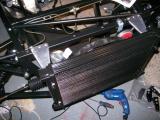 |
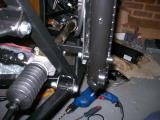 |
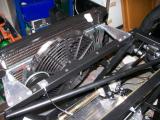 |
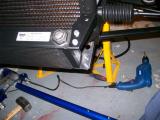 |
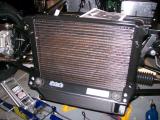 |
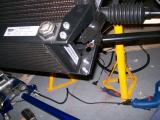 |
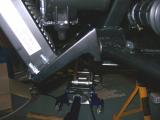 |
This is the milestone that any car builder looks forward to. The day the engine goes in is the day that the rolling chassis becomes a car, and the light at the end of the tunnel becomes visible.
It's around noon, Kriss and Jonny have just arrived, and the engine is fully prepared ready for fitting. We walk around for a bit weighing up the best way to go about it, and decide to move the engine and pallet over to the offside next to the engine bay. Kriss then suggested that we cover the top chassis rail so it didn't get scratched by the engine, so some packing card was taped over it.
The engine can be lifted quite comfortably by two people, but due to the chassis still being quite high on axle stands, there were 4 of us. Kriss and Jonny and I lifted the engine up to about chest height, but we couldn't get it into the engine bay as we were all in each others way.
Jonny was already looking at numbers for engine crane hire, but I knew it would go in manually. The problem was getting the engine into the engine bay, so I suggested that Matt should stand inside the engine bay so Kriss and Jonny could pass it to him to support, then he could pass it to me to support and duck out, leaving the 3 of us to lower it down.
In the end Matt just put one leg into the engine bay and one outside. Jonny and Kriss lifted the engine to around chest height, passed it towards Matt so the 3 of them supported it, then he slipped his leg out whilst I supported part of the engine frame. Now we just lowered it down into position.
Problem! It won't sit on its mounts. If it sits correctly on one side, the other side was about an inch too low. We tried a few things, but nothing would line up. Jonny took a look at the manual and quickly worked out that the engine frame was fixed on the wrong side of the engine brackets at either end (see previous post here for more details).
So back out the engine came, and we quickly swapped the frame to sit the other side of the brackets. We had to remove the whole thing, but it didn't take long. We lifted the engine back in using the exact same technique as before, but this time it sat on its mounting locations perfectly.
The engine was finally in - well nearly. It's not bolted down, but you can't bolt it down until you have the bodywork in place. The trick is to fit the bodywork, and then the exhaust. When the exhaust lines up with the bodywork for mounting, you can drill your holes in the engine mounting brackets and then bolt it down.
I think that this went fairly well, except the pictures. I let Matt take them and they are all blurry (again). Sorry!
Laurence
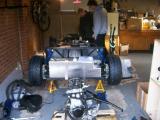 |
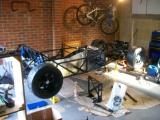 |
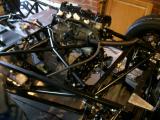 |
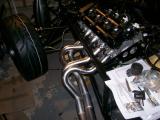 |
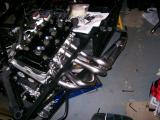 |
I had looked at the seats many times, and just got confused by the parts and fixings. This is another area that is left completely up to your imagination, as it's not in either manual. I spoke to Mark at the factory about them, and I have a pretty good idea what to do.
It was a bit of a gray area, so I'll explain how you do it here.
The first step is to fix the runners to the sub frames. Although the sliders are present, you still have options on how far forward or back the seats can be fitted, so you slide a few inches forward and back of a base location. Matt and I are both just over 6ft, so we decided that the base location should be as far back as possible, so we used the forward-most holes on the sub frame as our fixing points.
You also need to poke a bolt through each of the seat sliders. There is a stud at the rear of each slider, so you need to fit the bolt at the front of each.
The seat can now be placed into the sub frame. My pictures don't make it very clear, but the front of the sub frame higher than the rear, so when the seat is placed in the frame, is is automatically rocked backwards slightly. Place the sub frame on the floor and sit in the seat to make sure the seat is squashed fully into place. We did this, and when we were happy, you drill the front seat holes. The holes are already present in the frame, so you just need to follow them through into the seat with a drill.
Once we did this, we bolted the front of the seats to the frame. You use a large dome washer which has a nice recess for the countersunk bolt on the inside of the seat so the bolt doesn't poke into you.
The sequence is (from inside of the seat outwards): countersunk bolt, large dome washer, seat, sub frame, small washer, nut. Now the front of the seat is fixed, but the rear has movement, so you can adjust how steep the seat is.
To do this, fit the seat into the car. You will need to drill through the aluminium in the car - you'll see exactly where as the holes are already there on the seat mounting points. Just make sure you drill through the correct holes, as there are more than one set. On out chassis it was the inner set of holes.
With the seat sitting in place, jump in the seat and make sure you are happy with the angle. You can adjust it by placing bits of wood between the seat and the sub frame to raise it, but we were happy with how the seat fits when resting at the bottom of the frame - it gave us the perfect angle. We removed the seats from the car, drilled the rear holes into the seats, and then fastened in exactly the same way as above.
Finally, we re-fitted the seats and bolted them into the car. You will need to use a large washer under each bolt so it rests between the bolt, and the underside of the floor-pan. To tighten the front bolts you will need to slide the seat back and put an Allen key into the bolt to stop it spinning.
This was even more exciting than the engine going in, because we could finally sit in our car and visualise it. Matt got a bit carried away with it all though - see photos!
Last job is to fit the harnesses into position. We have 2 sets of harnesses, but only one fixing kit, so we'll have to call Westfield about the missing kit. Anyway, the bottom of the harnesses bolt into the side of the frame using the supplied bolt, a washer, and a locking serrated washer. The tops just clip into eye bolts which must be fitted just behind the headrests with the supplied spacer.
Laurence
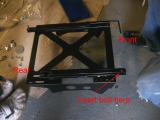 |
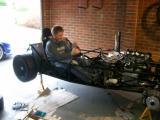 |
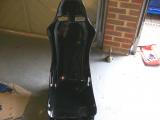 |
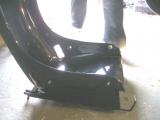 |
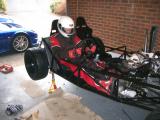 |
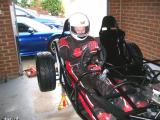 |
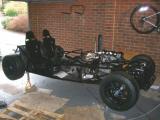 |
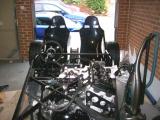 |
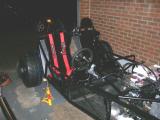 |
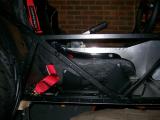 |
The reverse box had been installed for some time, but the linkage to set the reverse box into forward or reverse had not been installed, so this was the first thing I wanted to tackle tonight.
The bracket must not stick up above the rail, but this was difficult since the bracket is taller than the rail and the mounting holes are too near the bottom of the rail to drill into when the bracket is pushed level with the rail, so i decided to enlarge the bracket holes slightly so that it would sit lower. This gave an extra mm clearance and the bracket will now sit nicely.
I drilled through both sides of the chassis rail at the lowest point possible. This was easy for the hole on the right, but the left hole had to be drilled at a big angle so it was quite difficult. I removed the bracket, fitted the lever and mounting bush, and bolted it into place. Remember to put the bracket mounting bolts in first!
The bracket bolts nicely into the chassis rail, so now it just needs connecting up. I fitted the rose joints into the rod and then bolted them into place. It was just a case of trial and error with the length, and more importantly the clearance of the prop when in reverse. It's fine when in forward gear, but quite close to the prop in reverse. Hopefully it should be ok though.
Now I moved on to the fuel tank plumbing. There are a couple of inserts for the fuel tank which need bolting in for the fuel hose to attach to, then just a case of following the lines that the manual suggests and securing. I used quite a bit of protective tubing in case there is any movement.
Whilst I did this, Matt tackled one of the outer aluminium panels which seal the outside of the car. The only problem was that my air compressor had broken. Matt said he was quite happy to do it by hand though. He got 3/4 of the way through them, and then caught his thumb between the handles which put him out of action for the rest of the evening. It would hurt under any circumstances, but with the cold as well, it hurt him twice as much. I finished the last few off before the silicon dried though even though I didn't want to.
After just a few my hands really hurt. I'll buy another compressor tomorrow and do the other side with the air riveter. I'm not going to damage my hands anymore!
Laurence
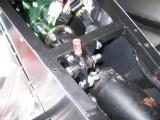 |
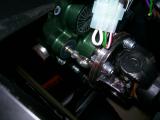 |
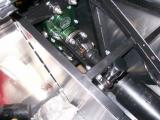 |
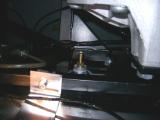 |
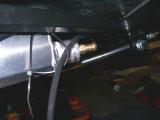 |
I got my new compressor today, so we could fit the remaining side panel into place this evening with the aid of an air riveter. 15 minutes later the job was done! The air riveter just makes such light work of it all. Apart from fitting the 2nd side panel into place I had set tonight aside for a few odds and ends that needed attention. The one that was annoying me the most was the stud that goes through the lower frame of the engine. These studs have a habit of threading on one bolt, but not the other because they spin the entire stud through the opposite nut to the one you want to tighten., so you end up with a load of thread sticking through one bolt, and none through the other meaning the nyloc cannot do its job.
There are a few ways around this, but there is such little room on this stud that the only way I could get the stud evenly spaced was to remove the stud, place a nut on one end, and fit a nut that was too small for the thread on the other. Now when you tighten both bolts towards each other, the smaller bolt locks against the thread, and allows you to tighten the other through the nylon - WINNER!
The other odd job that was annoying me the 2nd most was on the differential. There is a 16mm spacer which spaces the diff on the upper stud, but we originally couldn't find this so we used M12 washers and later needed those washers. The spacer was in a clear plastic bag with all of the pedal bushes, gear shift rose joints, and other bits. It was annoying me, so I changed it.
Both diff studs needed slackening, and the top one removing (which meant the brake pipe T-piece had to be removed). I then had to loosen the driveshaft nuts, and the bracket that secures the diff at the rear. The diff needed levering over with a pry-bar to make room, and after about an hour of struggling, hammering, levering, and swearing, my Dad and I finally got it into place and tightened everything up.
The last thing I wanted to do tonight was fit the remaining 2 fuel hoses - one from tank to fuel pump, and the other from return line to tank. I cut the pipes to length, cable tied them up with the wiring loom, and then placed the protective tubing over the top. The garage is a total mess with tools and bits everywhere, so before I finish I had a good old tidy-up ready for next time. We are very close to starting the bodywork now.
(Again, I forgot to take pictures!)
Laurence
Wednesday is normally a night when Matt and I go out with our mates for a beer and a catch-up, but it has become an unofficial car night. It's ok though because the mates we would normally meet come round to help us instead of drinking beer, so we're not social outcasts after all.
Kriss was looking forward to the body preparation and really wanted to be involved, so he and Jonny got round about 7:30pm and we started work. We went and got the main body panel from the greenhouse where it had sat under covers since collection, and Matt retrieved the rear arches from the loft. We moved the Noble, and sat the bodywork down in a nice big space next to the car on a blanket for protection.
We rubbed the arch locating blocks down removing any rough edges to ensure a flush fit, and then Jonny and I set about bolting the arches to the main body section. We G-clamped each arch in 3 places, then marked the 10 holes we were going to drill. It quite weird, but the drill literally gets pulled through the plastic once the hole is drilled, and you really have to be ready for it!
Whilst we were doing this, Matt and Kriss removed the manifold from the engine so the body panel could sit in place once all of the preparation had been done. It didn't take long before both arches were firmly fitted to the body. The fit is generally good, although the gaps at the bottom of the arches is a little bigger than the rest. Nothing to worry about though.
Now the rear lights could be fitted to the body - indicators pointing outwards. I was glad Kriss was here for this, because he has a good eye for lining things up, and although the lights already have mounting points, there is still plenty of room to get things wrong, and once you have drilled...
We decided on a final location, then removed the light and drilled a hole in the centre for the wires to route through. We then held the light back in position and drilled the 4 holes using the bracket as a template - this way the 4 holes will ALWAYS line up (even if they are not straight).
The lights look good, so we secure the brackets into place (using a p-clip on one bolt to secure the wires) and then fit the light cover. The lights look terrible as units, and we might well upgrade them to the rounded type. They fit nicely though.
Now the fog light can be fitted, but it has no actual mounting point, so we have to be very careful with its position. It looks really easy, but we were very careful with the measurements and the whole process took most of the night.
Jonny and Kriss were a big help with it, and as a last team effort before they have to leave, we picked up the body and placed it onto the chassis, stand back, and admire! The colour looks fantastic, and so does the car. We stop for a bit, feeling very happy with our achievements so far.
Matt and I carried on for a bit, and made sure the body was correctly aligned. We then looked at the roll-bar but decided it was pointless fitting it as we already had the mounting points for the RAC roll bar, so we just put it back down and decided we'd order the RAC the next day. A great night's work on the car which left all of us feeling very happy.
Laurence
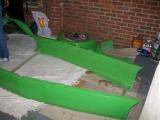 |
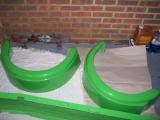 |
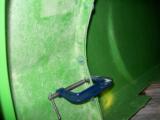 |
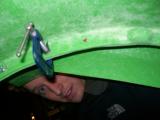 |
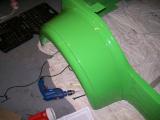 |
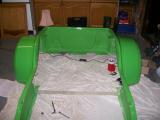 |
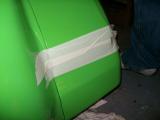 |
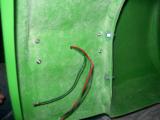 |
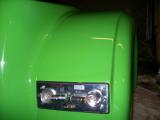 |
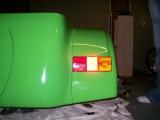 |
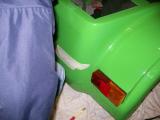 |
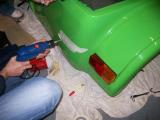 |
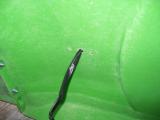 |
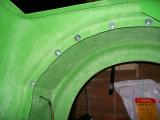 |
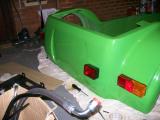 |
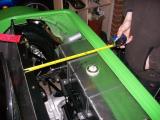 |
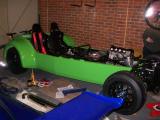 |